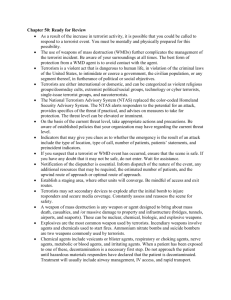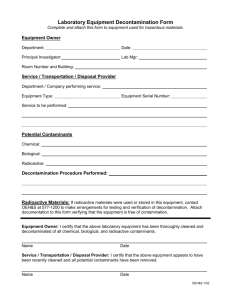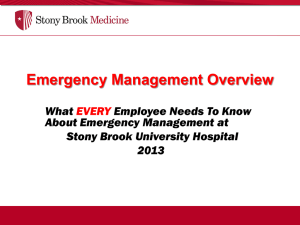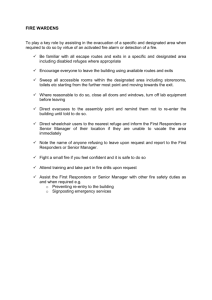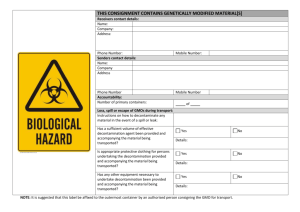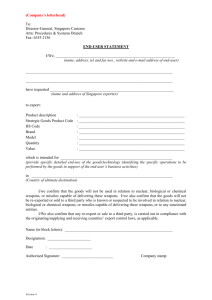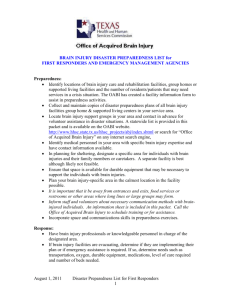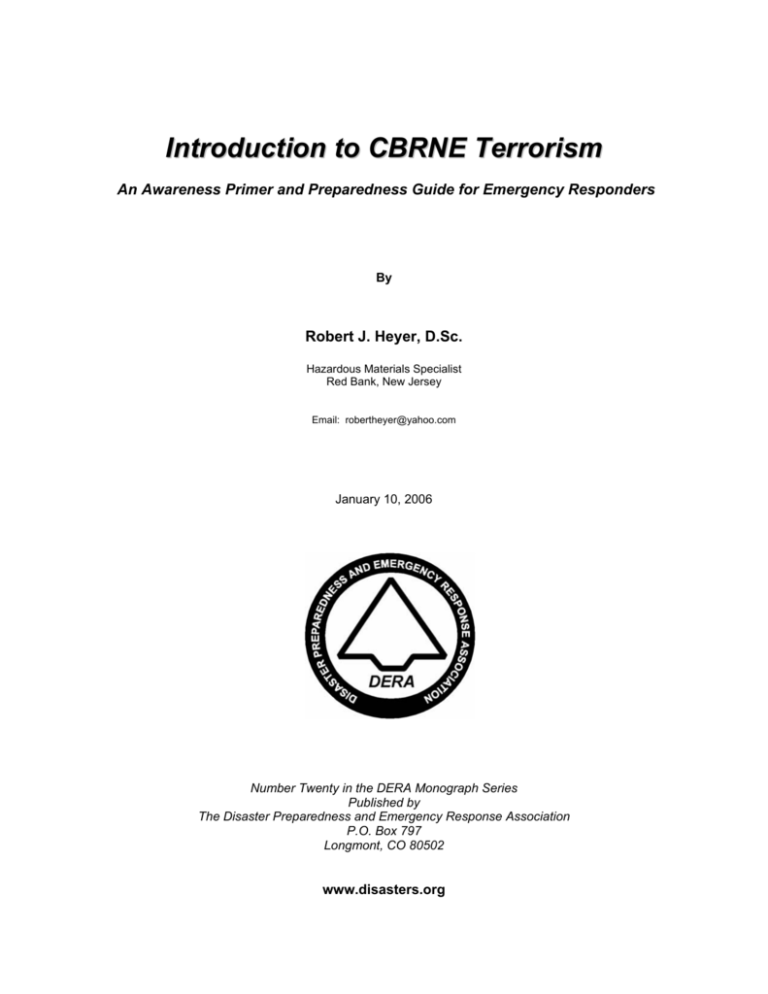
Introduction to CBRNE Terrorism
An Awareness Primer and Preparedness Guide for Emergency Responders
By
Robert J. Heyer, D.Sc.
Hazardous Materials Specialist
Red Bank, New Jersey
Email: robertheyer@yahoo.com
January 10, 2006
Number Twenty in the DERA Monograph Series
Published by
The Disaster Preparedness and Emergency Response Association
P.O. Box 797
Longmont, CO 80502
www.disasters.org
Introduction to CBRNE Terrorism: An Awareness Primer and Preparedness Guide for Emergency Responders
By Robert J. Heyer, D.Sc.
Number Twenty in the DERA Monograph Series
Published by The Disaster Preparedness and Emergency Response Association
P.O. Box 797, Longmont, CO 80502
Editor: Dennis I. O'Quinn
October 15, 2001; Revised April 7, 2003; January 10, 2006
ISSN 1521-1592
Copyright © 2001, 2003, 2006, DERA International. This publication may not be reproduced in whole or in part without express
prior permission of the Disaster Preparedness and Emergency Response Association, Inc. (DERA), P.O. Box 797, Longmont,
Colorado, 80502 USA. Worldwide rights reserved. DERA and the DERA Logo are Trademarks (™} of the Disaster Preparedness
and Emergency Response Association, Ind.. Notice to academics, governmental agencies and nonprofit organizations: Permission
to reprint this publication will normally be granted upon request. Fair Use Doctrine applies. You are welcome to quote portions of
this document for research and educational purposes, provided credit is given to the author and a full reference citation is included
in your bibliography/works cited. All commercial use requires prior approval. Address questions or inquiries to:
dera@disasters.org. Views and opinions expressed in this document are those of the author and do not necessarily represent
DERA or other organizations or persons mentioned in this publication. Information presented herein, although believed to be
accurate, is intended only for professional and academic consideration. Neither DERA, the author, nor the editors assume any
liability resulting from the use of this information, nor for its accuracy or completeness.
Table of Contents
Topic
Page
Introduction........................................................................................................................
1
Conventional Weapons and Explosives...........................................................................
2
Nuclear and Radioactive Weapons..................................................................................
3
Chemical Weapons..........................................................................................................
3
Biological Weapons..........................................................................................................
4
Handling Suspicious Mail.................................................................................................
4
Emergency Decontamination..........................................................................................
5
Self Protection for Responders........................................................................................
6
Establishing an Emergency Command Post...................................................................
7
General Safety Guidelines..............................................................................................
8
Early Indicators of Attack.................................................................................................
8
Likely Targets..................................................................................................................
9
Conclusion and Recommendations................................................................................
9
Table of Properties for Major Chemical and Biological Agents......................................
10
DERA Mission Statement and Membership Invitation....................................................
11
Introduction to CBRNE Terrorism
An Awareness Primer and Preparedness Guide for Emergency Responders
By
1
Robert J. Heyer, D.Sc.
Red Bank, New Jersey
INTRODUCTION
As demonstrated recently, even small groups of individuals have the ability to cause massive
damage and extensive human suffering with little or no warning. Predictably, firefighters, police
officers, EMS personnel, and civilian volunteers will respond and be on the scene moments
after any attack occurs. For such events in the future, however, rescue and treatment of victims
and control or containment of fire and other hazards will be greatly complicated by the fact that
the site may also be contaminated with nuclear, chemical, biological or radiological substances
that pose an immediate threat to the health and safety of the emergency responders.
Also, the immediate impact of such attacks may reach much further than the scene of the
disaster. Thousands of injured and potentially contaminated victims may depart the scene,
returning to the suburbs and satellite cities where they reside, or privately seeking medical
assistance.
Emergency responders in metropolitan areas and far beyond will need to move quickly to deal
with this predictable exodus from cities following any attack.
This primer is an introduction to the types of weapons first responders may be exposed to in a
terrorist attack. Responders need to be ready to deal with any possible situation quickly,
efficiently and professionally. Knowledge of Chemical, Biological, Radiological, nuclear and
Explosive weapons (CBRNE) is needed for every first responder.
This paper is intended to provide an awareness-level introduction to the subject for first
responders and community officials. The intention of this paper is to give responders and those
managing community emergency programs enough basic information to safeguard themselves
and those for whom they are responsible. This material should also be suitable for use as
talking points for public information officers and those training or educating volunteer
organizations or the general public.
This information in this paper is not sufficient to prepare responders to work in contaminated
areas. Those workers require training at the Operations, Technician and higher levels.
With proper awareness and preparedness, we can save lives and reduce the impact of any
potential terrorist attack.
1
Dr. Heyer is a biologist with extensive field experience in emergency response, hazardous materials situation management,
bioenvironmental protection, infection control, radiological protection and respiratory protection. He is currently a Captain with the
Red Bank (New Jersey) Fire Department, and was assigned as a decontamination operations manager for two field teams
supporting evacuees and first responders from the World Trade Center disaster operations on September 11, 2001. He may be
contacted via Email at: robertheyer@yahoo.com
-1-
What types of weapons might be used?
Terrorists potentially have a wide range of available weapons, ranging from very simple to exceedingly
complex. With knowledge, preparation and training, first responders can safely deal with the
consequences of each.
In general, terrorist weapons can be categorized into four major types. It is important to remember that
different types of weapons can be combined or used sequentially. Terrorist weapons are often referred to
as weapons of mass destruction (WMD) because of the ability to kill large numbers of people.
The four categories of weapons are:
1. Conventional Weapons & Explosives.
2. Nuclear and Radioactive Weapons.
3. Chemical Weapons.
4. Biological Weapons.
Conventional Weapons and Explosives
The most likely type of terrorist weapon is a conventional explosive device. Some of these conventional
weapons pack a very powerful punch and can bring down large buildings. The casualties could number in
the hundreds in this type of attack. One example of this type weapon was the fuel oil-fertilizer bomb used
to attack the Murrah Federal Building in Oklahoma City.
First responders should be alert to the potential for structure collapse as well as secondary explosive
devices in the area.
Great caution should be used if the explosion seems to do little damage. A small explosive device might
be used to disperse chemical, biological or even radioactive agents. Another purpose of a small device
might be to bring large numbers of first responders, who are then subjected to a larger secondary device.
Another immediate problem for responders and victims is the potential for asbestos exposure. Older
buildings may contain asbestos as insulation, pipe coverings, siding or roofing, flooring, adhesives, floor
or ceiling tile and wall panels. Any explosion or collapse may cause this asbestos to become airborne in
hazardous levels.
Immediately, the primary inhalation threat and decontamination problem will be dust. Any expedient
breathing protection should be used--masks, wet towels, handkerchiefs, etc.--while exiting the area
immediately. Footbaths and wash-downs are most effect for decontamination of normal conventional
incidents if asbestos exposure is suspected. Eye washing with clean water is usually needed
immediately as well.
Terrorists recently utilized a new type of conventional weapon, the airplane. Quantities of residual,
unburned fuel may remain when an aircraft is used as the weapon of attack. In addition to the resultant
fire hazard, aviation gasoline and jet fuel are hazardous substances, and decontamination efforts may
need to include removal of fuel contaminant.
As with all hazardous materials incidents, refer to the Emergency Response Guidebook for evacuation,
protection and decontamination procedures.
-2-
Nuclear and Radiological Weapons
It is very unlikely that terrorists will have access to a functional nuclear weapon in the near future.
Nevertheless, it should be remembered that suitcase-sized nuclear devices have been reported missing
from military storage areas in the former Soviet Union. This does lead to the possibility of these devices
becoming available to terrorist organizations. Therefore, response and planning agencies cannot totally
rule out the possibility that terrorists will attempt to transport and use nuclear devices.
It is much more likely that terrorists may attempt to use conventional weapons to attack nuclear power
plants or radioactive waste storage or processing facilities. Another potential is that a conventional
explosive might be used to spread radioactive materials over a large area.
Radiation comes from the decay of radioactive isotopes of certain elements and compounds. Radiation
can be in the form of alpha, beta, or gamma rays. All three are odorless and colorless and can be
detected only with radiation detectors.
The primary hazard will be from dust contaminated with radioactive sources. It will be very important for
the first responder to use respiratory protection to avoid breathing in the radioactive dust. Footbaths and
wash-downs will be a useful in the decontamination of victims. Detergent can be added to the water to
remove the radioactive dust. It is very important to collect all water and contain the runoff, as it will also be
radioactive.
First responders who are not properly trained and adequately equipped should not enter radioactive
areas or make contact with people or items that are contaminated.
Chemical Weapons
Terrorists have used chemical weapons in the recent past and it is likely to happen again. A very large
number of casualties could be expected in a successful chemical attack.
Chemical agents can enter the body by inhalation of the chemical agents, absorption through the skin or
eyes, injection into the body by flying glass or shrapnel, or by ingesting with food or water. A likely
delivery method is in the form of a gas or as an aerosol spray.
There are numerous chemical agents each with different symptoms and effects. Please see Appendix A
for more detailed information on the more common types of agents. The most common families of
chemical agents are:
Nerve Agents: Nerve agents attack the victim’s nervous system. Most belong to the family of
chemicals known as organophosphates. Many common pesticides belong to this family of
chemicals.
Blister Agents: Blister agents also known as vesicants attack the skin of the victim resulting in
blisters and skin burns. Mustard gas and Lewisite are common blister agents.
Blood Agents: Blood agents attack the ability of the blood to hold and deliver oxygen. The victim
suffocates. Cyanide gases and compounds are the most common types of these agents.
Choking Agents: These chemicals attack the lungs causing them to fill with fluid. Chlorine gas and
phosgene are typical choking agents.
Incapacitating Agents: These agents usually irritate the skin, mucous membranes, eyes, nose,
lips and mouth. They may cause vomiting or intolerable pain. While they may lead to serious
medical situations such as seizures or heart attacks, they are not designed to kill or cause
permanent harm. Used alone, the intention is to temporarily incapacitate or harass the target, or
force them to evacuate the area. However, incapacitating agents may be used in combination with
other agents to force responders to remove their gas masks and other protective gear, so that they
will be exposed to lethal doses of the other agent. Examples of incapacitating agents are pepper
spray, tear gas, riot control agents and several military chemicals from different nations.
-3-
Biological Weapons
Biological weapons present a serious challenge for response planning. There is risk that a biological
attack may not be detected until days or even weeks after it happens. First responder resources,
therefore, may be of little use at a bioterrorism incident unless it is detected promptly.
Basically, there are two types of biological weapons:
Pathogens: These are disease-causing organisms, some of which can reproduce and keep
spreading long after the attack. The potential for many thousands of casualties is possible but the
more likely number is much less because of the difficulty of efficiently delivering the pathogenic
agents to large numbers of people.
• Pathogens can be bacteria such as anthrax, viruses such as smallpox, or fungi like yeast and
molds, mycoplasmas that cause pneumonia and similar problems, or rickettsiae. Plague,
smallpox, anthrax, hemorrhagic fever, and rabbit fever are known to be probable biological
weapons.
• Not all diseases are contagious, and many have a low mortality rate when properly treated.
Toxins: Toxins are poisonous substances produced by living things. Many toxins are extremely lethal
and small quantities can kill very large numbers of people. In many ways a toxin attack is more like a
chemical attack than a biological one. Some possible toxin weapons are ricin, botulism toxin, and
aflatoxin. Again, the difficulty for the terrorist is in finding an effective way to disperse or distribute the
toxin.
Handling Suspicious Mail
What makes a piece of mail suspicious?
•
•
•
•
•
•
•
•
It's unexpected or from someone you don't know.
It's addressed to someone no longer at your address.
It's handwritten and has no return address, or bears one that you can't confirm as legitimate.
It's lopsided or lumpy in appearance, or contains inappropriate powders or liquids.
It's sealed with excessive amounts of tape.
It's marked with restrictive endorsements such as "Personal" or "Confidential."
It has excessive postage.
It seems to have traces of a suspicious powder or liquid, with or without odors.
SUSPICIOUS MAIL
- Do not handle a letter or package that you suspect is contaminated.
- Do not shake it, bump it, or sniff it.
- Cover the suspicious item with paper, plastic or cloth, if handy.
- Turn off fans. Get away.
- Wash your hands thoroughly with soap and water.
- Notify local law enforcement authorities.
-4-
Emergency Decontamination
Decontamination of victims is critical within 1-2 minutes if a nerve, blood, blister, or choking agent has
been encountered. Do not delay.
Use water from any uncontaminated source to spray or douse victims. Do not delay to obtain soap
or to remove clothing.
Immediately and repeatedly flush the eyes with large amounts of clean water.
FLUSH-STRIP-FLUSH-RUN: Have victims discard all clothing and go through another water
spray, using soap if available: Move them upwind immediately. Avoid contact with the victims or
anything they touched if you are not wearing appropriate protective gear.
.
If standard decontamination capability is not available after the above flush-strip-flush-run, have
victims quickly get to a safe area and shower with large amounts of warm water, vigorously using
detergent soap (such as dishwashing liquid or strong bath soap) and using scrub brushes if
available. Avoid contaminated water streaming into the eyes, especially from the hair.
If standard decontamination solution is still not available, start expedient decontamination
using a 0.5% hypochlorite solution (1 part household bleach mixed with 9 parts water).
•
Spray or pour over the victims. Ordinary spray bottles or plant misters may be used. Do
not mix this solution with glass cleaners, such as Windex®
•
The solution can be used on soft tissue wounds, but must not contact the eyes or enter
open wounds of the abdomen, chest, brain, or spine.
If biological agents are suspected, leave the hypochlorite solution in contact for 10-15
minutes before rinsing. Less time is needed for chemical agents.
Isolate the victims and keep them warm and hydrated until standard decontamination can be
performed.
(Decontamination, Cont'd)
Assume that this situation is at least a HAZMAT Level A emergency involving Toxic-by-InhalationHazards (TIH).
Lacking other guidance, implement isolation and evacuation distances in accordance with Green Pages
Section of the Emergency Response Guidebook, for release of a TIH of best-guess quantity.
Unless responders are properly trained and equipped, do not send them into the area for rescue or
treatment of victims. Ill-prepared, heroic rescue attempts may only worsen the emergency by creating
additional victims and seriously reducing response capability.
All chemical weapons have the potential for secondary contamination of ambulances, police, fire and
medical equipment, hospitals, busses, private vehicles, homes, and other people encountered by victims
as they leave the scene.
Proper decontamination of victims is necessary before they leave the area and spread the contamination.
Ideally, decontamination stations should be set up at all mass transportation sites serving the area in the
event of a chemical attack.
-5-
Self Protection for Responders
Barrier protection, reducing the time of exposure and distancing yourself from the hazard are
the keys to survival for all first responders.
The best available barrier should be put between you and the nuclear, chemical, or
biological agent. The only way to protect yourself is to keep the hazard from
entering or coming in contact with your body. For most situations, your eyes and
all of your skin must be covered quickly before you become contaminated, and you
must adequately filter the air you breath.
In some cases, respirator filters will not fully protect you from all chemical or
biological hazards, and supplied-air breathing apparatus must be used if you are in
the contaminated area. If you are using a filter respirator, you must make certain
that you have installed the correct filter type and that it is certified to protect you
from the specific NBC hazard.
Reduce the time you are exposed to the agent as much as possible. If you are not
properly trained and equipped to deal with a hazardous substance, you should not
be in a contaminated area.
If you are caught without a mask or other protective equipment, move out of the
contamination as quickly as possible, using any expedient means of creating a
barrier between yourself and the hazard. Layers of clothing, rain slickers, hats, ski
goggles, wet towels or handkerchiefs over the face may help. Get away quickly and
decontaminate immediately.
After working in the incident area, proper decontamination of you and your equipment will
probably be required for your own protection as well as that of others. If in doubt, confirm the
need for decontamination with the Incident Commander, safety officer, or chief of your local
HAZMAT team before leaving the evacuation assembly area. If you suspect that you or others
are contaminated, and you cannot get prompt guidance, you should perform expedient
decontamination without delay.
- 6 -
How can you establish a safe command post for the incident?
Preplanning, training and exercises are essential if you are going to be able to make decisions in a crisis.
The following guide is intended to assist planning and preparedness, but local conditions and technical
considerations may become overriding factors. Use the following outline as a guide only.
Unless there is other guidance, assume that any NBC terrorist attack creates at least a HAZMAT Level A
situation involving Toxic-by-Inhalation- Hazards (TIH).
Lacking other guidance or specific information, implement evacuation, isolation and protection distances
in accordance with Green Pages Section of the Emergency Response Guidebook, for release of a TIH of
best-guess quantity.
Establish the Incident Command Center and all staging areas well outside the most pessimistic danger
zone. With specialized equipment and highly trained teams, it would be possible to deliberately establish
operating facilities within the zone of contamination, when no other practical solution exists. If you have
the need for this capability, contact your regional Civil Support Team for advice and guidance.
If, however, emergency response teams or command officers find themselves suddenly and unexpectedly
in an area from which they cannot escape, or if there is no choice but to establish a command post close
to the incident site, there are expedient defensive measures that will reduce--but not eliminate--risk. The
following precautions may be helpful when forced to operate inside or near the hazard area.
Locate the command post upwind from the hazard hot zone.
Locate the emergency refuge or command center inside a building as opposed to
using a vehicle. Buildings provide greater physical protection and are much easier
to seal against chemical and biological hazards.
Select the most protected interior room available. As many hazardous fumes are
heavier than air, an interior room on a middle floor of the building might be
advisable.
Shut off central fans and air handling equipment.
Establish a decontamination station at the entrance to the facility to prevent
contamination from being carried inside.
Windows and doors should be covered with plastic and sealed with duct tape.
If possible, a HEPA filter should be placed in the temporary field station and a
positive room pressure generated.
The room should remain sealed until after the chemical or biological plume has
totally passed the area.
If possible, keep escape vehicles in a nearby garage or other protected area in case
emergency evacuation is needed. Cover with plastic or blankets if left outdoors.
Establish a site evacuation and rescue plan
Sealing windows and doors to make a safe room may also be desirable for anyone trapped in the danger
area when there is no time to evacuate them to a safer area. It is important to ensure that occupants will
have enough air to prevent suffocation.
- 7 -
General Safety Procedures at Terrorist Incidents.
1. Suspect the worst at all terrorist incidents until the air is tested.
2. Use barrier protection until the area is tested to be safe.
3. Establish decontamination stations as soon as possible.
4. Contain all run off from decontamination activities.
5. Be on the alert for structural collapses.
6. Be on the alert for secondary explosive devices.
7. Remember you are part of a crime scene and preserve all evidence when possible.
What are the early indicators of a possible CBRNE attack?
There are many early-warning indicators of a CBRNE attack. In all but the large cities detection
equipment may not be available. All first responders should consider whether an attack might have taken
place if any of the following are noticed.
Unusual numbers of people dying in an area, or from strange causes
Unusual numbers of sick or dying animals, birds or fish
Lack of insect life where it should be seen
Unusual numbers of people in an area complaining of blisters/rashes, nausea,
disorientation, difficulty in breathing, convulsions, localized sweating, conjunctivitis
(reddening of the eyes), erythema (reddening of the skin), or any irregular symptoms
Strange colored smoke coming from the area of a detonation
Explosions that seem to do very little damage or which release an unusual amount of
smoke, or leave droplets of liquid in the area, or fragments covered with liquid or droplets
Unusual appearance of any liquid droplets, particularly where there should be none
Abandoned aerosol sprayers in the area of sick people
People reporting unusual odors or tastes
Unexplained mists or hazes in urban area
Sudden or unexplained appearance of low-lying clouds
Unidentified, low-flying aircraft--particularly crop dusters--over a populated area
-8-
What are the more likely targets for a CBRNE attack?
Government offices
Military installations
Landmark buildings
Events with high populations
Abortion clinics
Post offices
Power facilities
Water supplies
Corporate Headquarters
Police stations
Train terminals
Bus terminals
Airports
Tunnels
Bridges
Fuel depots
Cruise ships
In Conclusion
When approaching a scene that may involve CBRNE agents, the most critical consideration is the safety
of oneself and other responders. Protective clothing and respiratory protection at the appropriate level of
safety must be used. Be aware that the presence and identification of NBC agents may not be verifiable,
especially in the case of biological agents.
Whenever a CBRNE incident is suspected, immediately put on your protective equipment.
Remember the time-distance-shielding rule for protection: Spend as little time as possible in the
hazard zone, and keep your distance from the area. Shield yourself from the hazard at all times.
Decontaminate as soon and as thoroughly as possible.
Remember, your effectiveness as a first responder is compromised when you become a casualty
yourself. In addition you take resources away from the incident to care for you if you fall victim to the
incident.
The advice in this publication is general in nature, is not all encompassing, and may not be
applicable in every specific case. Please notify the publisher immediately of any changes needed.
-9-
Disaster Resource Center
P.O. Box 280795
Denver, CO 80228
www.disasters.org
Email: dera@disasters.org
QUICK REFERENCE GUIDE FOR PLANNING AND EXERCISES
Chemical Agents
Type
Symbol
Physical State
Stability
GA
GB
GD
VX
Liquid
Liquid
Liquid
Liquid
Stable
Fairly Stable
< GA or GB
Stable
H/HD
HN-1
HN-2
HN-3
HT
L
HL
CX
Liquid >14.5°C
Liquid
Liquid
Liquid
Liquid
Liquid > 0° C
Liquid
Unstable
Fairly Stable
Stable
Stable
Fairly Stable
Solid/Liquid
AC
CK
Vapor or
Liquid
Nerve
Blister
Blood
LT5O
ICT5O
Detox Rate
(mg-min/m3) (mq-min/m3)
400
300
Low
70-100
35-75
Low
70
50-300
Low
30-100
24-50
Low
Persistence
Decon
1-2 Days
Like Water
1-2 Days
Like Oil
DS2,
STB / HTH, or
Dilute Alkali
1500
1500
3000
1500
1500
1200-1500
1500
150 ¦
200 ¦
100 ¦
200 ¦
200 ¦
<300¦
200 ¦
Cumulative
Cumulative
Cumulative
Cumulative
Cumulative
Cumulative
Cumulative
1-2 Days
<HD
<HD
>HD
>HD
<HD
<HD
Unstable
3200
>3¦
Cumulative
Hours
Unstable
30 Days
2000-4000
11,000
Varied ¦
7000 z
Rapid
Minutes
Stable
Fairly Stable
Respiratory (Breathing)
LCT5O = Lethal Exposure for 50% Population
DS2, STB,
or
Fire
DS2, STB,
Caustic Soda
Water
None
Required
¦Ocular (Eyes)
ICT5O = Incapacitation Exposure for 50% Population
Biological Agents
Disease / Agent
Infection
Routes
Anthrax
S, D, R
Untreated Mortality Incubation Period
Estimate
S: 25%
1-4 Days
D: 50%
Sometimes 60 Days
R: 100%
(Bacillus anthracis)
Cholera
(Vibrio cholerae)
Hemorrhagic Fevers
Denge, Ebola, Lassa,
Marburg, Rift Valley, etc.
Plague
(Yersinia pestis)
Q Fever
(Coxielia bumetii)
Smallpox
(Variola Major)
Infective Dose
103 - 104 Spores
per Person
50%
1-5 Days
109 Organisms
per Person
Oral Rehydration
Antibiotics
DC, Uncertain
< 90%
2-7 Days
Unknown
Symptomatic
V, R
Bubonic - 50%
Pneumonic - I 00%
2-3 Days
10 Organisms
per Person
Antibiotics
V, R
< 1%
2-5 Days
I Organism
per Person
Antibiotics
Varies by strain and immunity
12-14 Days Typical
Unknown
DC, R, S
30-60% Anticipated
10-90% World History
(7 - 17 Extended Range)
No Primary Treatment
Suspect: 1-100 Viral
Organisms
VEE
Treat secondary infections as
symptoms occur
Incinerate, Autoclave or Chlorinedisinfect everything in contact with
patient. Cremate remains.
V, S, R
30-40%
2-4 Days
25 Organisms
per Person
Antibiotics
V, R
About 1%
2-5 Days
25 Viral Particles
per Person
Symptomatic
(Francisella Tularensis)
(Venezuelan Equine
Encephalitis)
Antibiotics
Ciprofloxacin preferred. Limited
effectiveness after symptoms develop.
Cremate remains.
D
Extremely Infectious 7-10 days after rash
Tularemia
(Rabbit Fever)
Best Treatment
D=Digestive System
R=Respiratory System
S=Skin
V=Vector
DC=Direct Contact
References: USPHS; Centers for Disease Control; U.S. Army SCBDCOM; US-DPO.
Information is presented for planning and exercise purposes only.
For response, treatment or decontamination, refer to official US Surgeon General publications, state/local health department orders, and approved medical protocols.
Membership Invitation
Established in 1962
MISSION
Preparedness - Response - Education
DERA is a Nonprofit Disaster Service and Professional Organization.
Our members work together as a world-wide professional network of disaster researchers, response and
recovery specialists, trainers, consultants, technical experts, and project managers.
We help disaster victims by improving communications and logistics, reducing risks and mitigating hazards,
conducting community preparedness workshops, and by sponsoring preparedness and response projects.
We sponsor a school awards program that encourages students to study the effects of disasters and
conduct projects to reduce hazards and improve community preparedness.
As a prominent international professional association, our membership is composed of key leaders in the field
of emergency management from around the world, including government officials, volunteers,
consultants, business managers, researchers, educators, students and charitable groups.
Our quarterly newsletter, DisasterCom, brings current information about developments in emergency
management and reports on the activities of our global membership.
We sponsor research projects and the publication of emergency management guides, case studies,
technical assessments, and preparedness materials.
If you share our vision of commitment and service, we would welcome you as a member.
Please complete the following application or contact us for further information.
DERA
P.O. Box 797
Longmont, CO 80502
Also, visit us at http://www.disasters.org
Professional Affiliation
Membership Application
Name: ________________________________________________ Title:_________________________
Organization: ________________________________________________________________________
Street Address: ______________________________________________________________________
City: _____________________________________ State: ___________ ZIP/Postal Code:__________
Country, if not USA or Canada: ___________________________ Phone: ________________________
Email:___________________________________________________ Radio Callsign:______________
Please Select Membership Classification
Enclose Check, Purchase Order, or Charge Card Authorization for Dues
T
T
Professional / Technical / Academic
$50.00 per year
$25.00 for Volunteer, Student, Retired
T
$75.00 per year
T
Executive / Management
$75.00 per year
T
Nonprofit Organizations
Gov’t Agency or Small Business
$95.00 per year
T
Lifetime Individual
$450.00
Corporate Membership
$250.00 per year
Amounts are in U.S. Dollars. Foreign currency and drafts are credited at commercial exchange rates. All checks must be payable through a U.S. bank.
Add $5 per year if you wish newsletter sent by Airmail, or $20 for Global Priority Mail. Rates good for 2005-2006.
CHARGE AUTHORIZATION
I authorize DERA to charge the following account for membership dues as marked above:
Please Check: T VISA
Card Number:
T MasterCard
T American Express T Discover T Purchase Order Attached
-
-
-
Expires:____ / ____
Month
Authorized Signature:___________________________________________
Year
Today's Date:______________
M29-01-06
MAIL APPLICATION TO:
Did a member refer you
for membership?
Name of Member:_______________________
DERA - Membership
P.O. Box 797
Longmont, CO 80502-0797
DERA was established in 1962 and is a Nonprofit U.S. IRS 501(c)(3) Tax Exempt Organization. FEIN 39-1777651.

